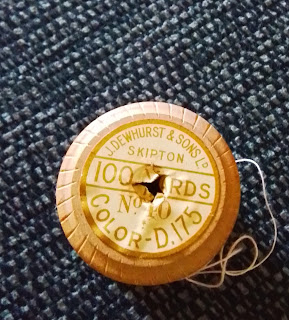Skipton by Train
An account of my trip to Skipton, written for the April edition of the Chesterfield and North Derbyshire Tinnitus Support Group newsletter:
Having been a collector and enthusiast of Sylko cotton reels for so long, it seemed to be the natural next step to visit the place where they had come from. The cotton had been dyed, processed, reeled up and packed at the Belle Vue Cotton Mill in Skipton, North Yorkshire, for many years until the demise of the British cotton industry. I knew that the mill was still standing, and had been converted into council offices and flats, so where better to head for on a summer day out?
Skipton is the gateway to the Yorkshire Dales and a popular tourist destination, so there is plenty to do besides track down old cotton mills! I am a nervous driver and never go anywhere long distance by car. I love trains, so whenever I need to go anywhere outside Derbyshire I always go by rail. I took the Cross Country train from Chesterfield to Leeds (about an hour) and then changed to the Leeds-Settle-Carlisle service. This is a scenic route and a popular way to see the Dales so the train was quite busy with people in hiking gear. The route follows the path of the River Aire for much of it and there is a lot to see from the window. Early on in the journey you pass through Saltaire and get a good view of the magnificent Salt's Mill. The stop previous to Skipton is Keighley, home of the Worth Valley Railway and it's very possible to see a steam engine waiting for passengers in the station. After departing this station, you can tell that you are leaving the "dark satanic mills" of West Yorkshire behind and crossing over into the more rural North Yorkshire and the edge of the Dales. There are sheep, pasture and winding rivers - and at one point I saw a deer casually watching the train pass while chewing on some foliage. It took just over half an hour to travel from Leeds to Skipton, meaning that overall my journey took less than 2 hours, which I was quite impressed with.
On exiting the station, it didn't take me long to find Belle Vue Mill - in fact I could hardly miss it! It stands across the road from the railway - which makes sense as this would have been the method of shipping in all of the raw materials and sending the finished reels out into the world.
As you can see from the photos, the mill chimney is still a prominent feature and the words "The Cotton Mill" proudly state the history of the associated buildings. Sadly it isn't possible to go inside - though if you search local estate agents you can see photos of some of the flats that are currently for sale. They look compact and neat with just the occasional trace of the building's former use, such as girders on show.
Around the back of the mill is the original means of transporting the goods - the Leeds and Liverpool Canal. This is now a bucolic walk but it would have once heaved with barges bringing in raw cotton. I walked along here, peering along different alleys and taking the close up photo of the chimney. As you pass the mill, there is a small bridge over the canal. This takes you directly into Aireville Park - a big expanse of grass and woodland heavily populated by rabbits. If you walk up through the park you arrive at what is now Skipton Academy School - but the original building at the heart of the complex was Aireville House. This was the home of the Dewhurst family, who owned the mill and the Sylko brand. As it is now a school I didn't dare take photos or try to get in to see it, but you can get an idea of how the Dewhursts lived, and imagine Algernon Dewhurst trotting through his parkland on his horse, heading to the mill to give out orders and check up on his business.
Walking back along the canal, you come to the town centre and into the hub of tourist Skipton. There is a canal basin, castle, church and many shops catering for the tourists. I head for Skipton Town Hall and the Museum of Craven Life, which is free to enter. This contains a small display about the mill, which was once one of the town's main employers. There are examples of packaging and a pristine set of cotton reels. There is also a board commemorating long serving employees which was taken from the mill when it closed. This shows that many people spent their whole working life producing Sylko reels and also the re-occuring surnames show how many families worked there.
My day was topped off with the best Fat Rascal bun I've ever had in a cafe by the canal. I head home again using the same train services and was back in time for tea.
Visit my Etsy shop SewSylko!









Comments
Post a Comment